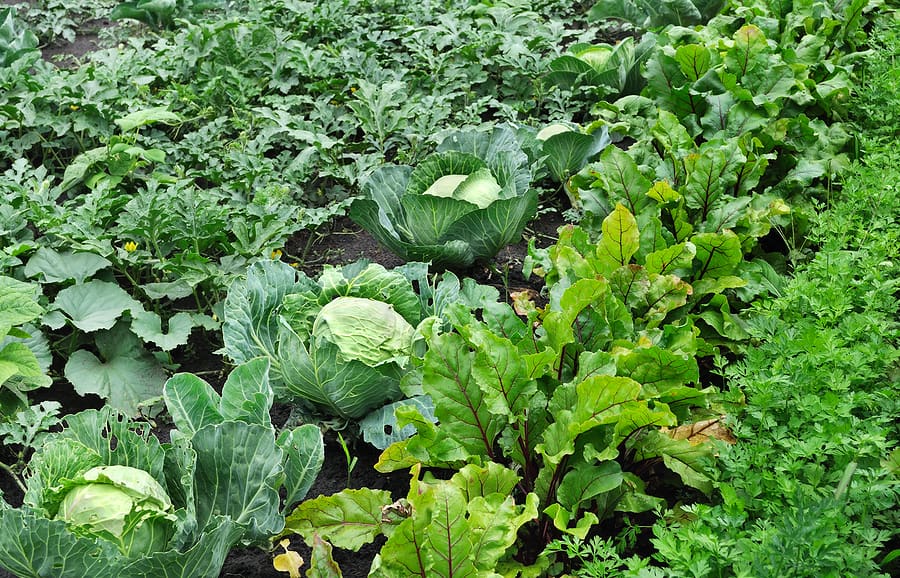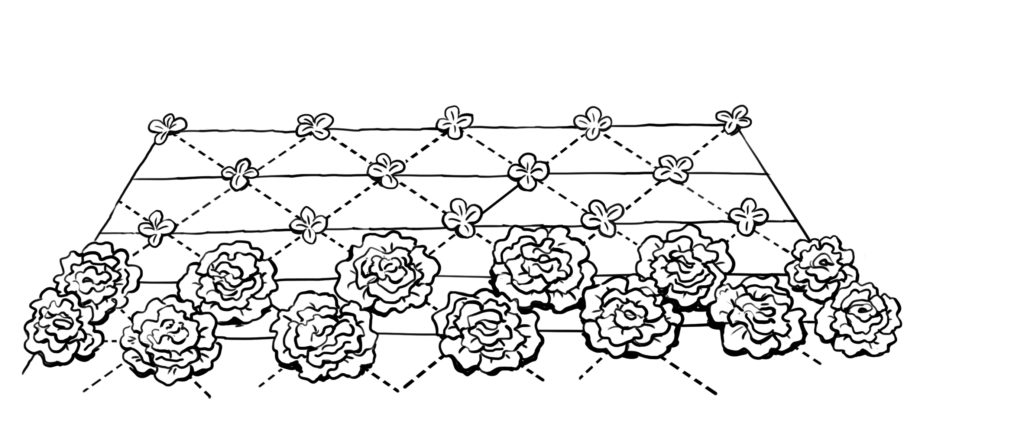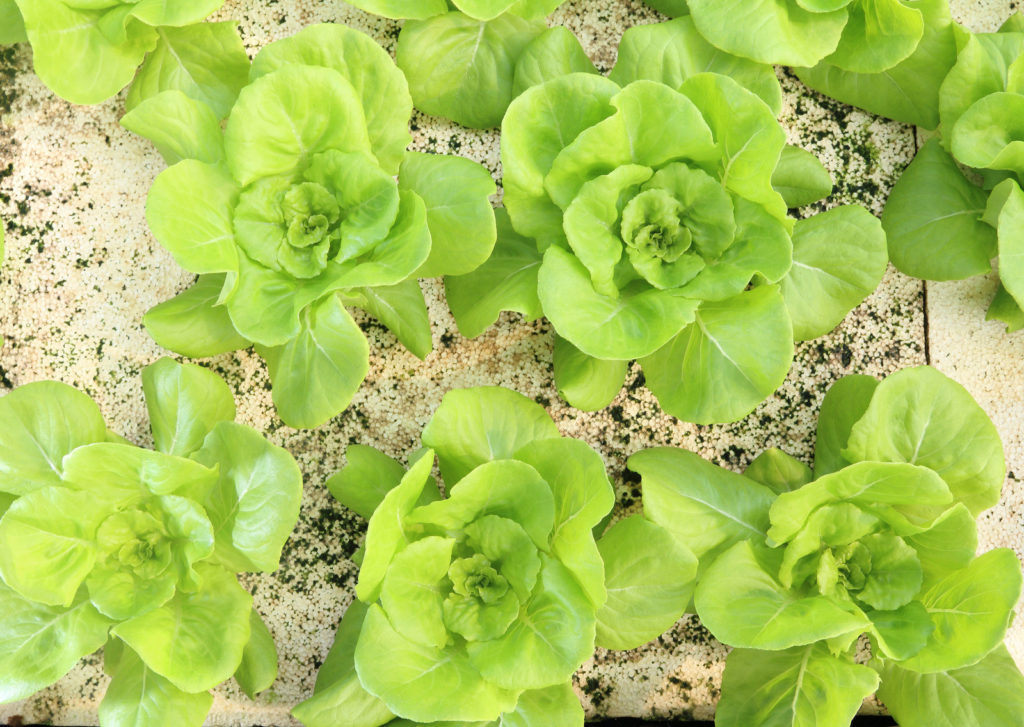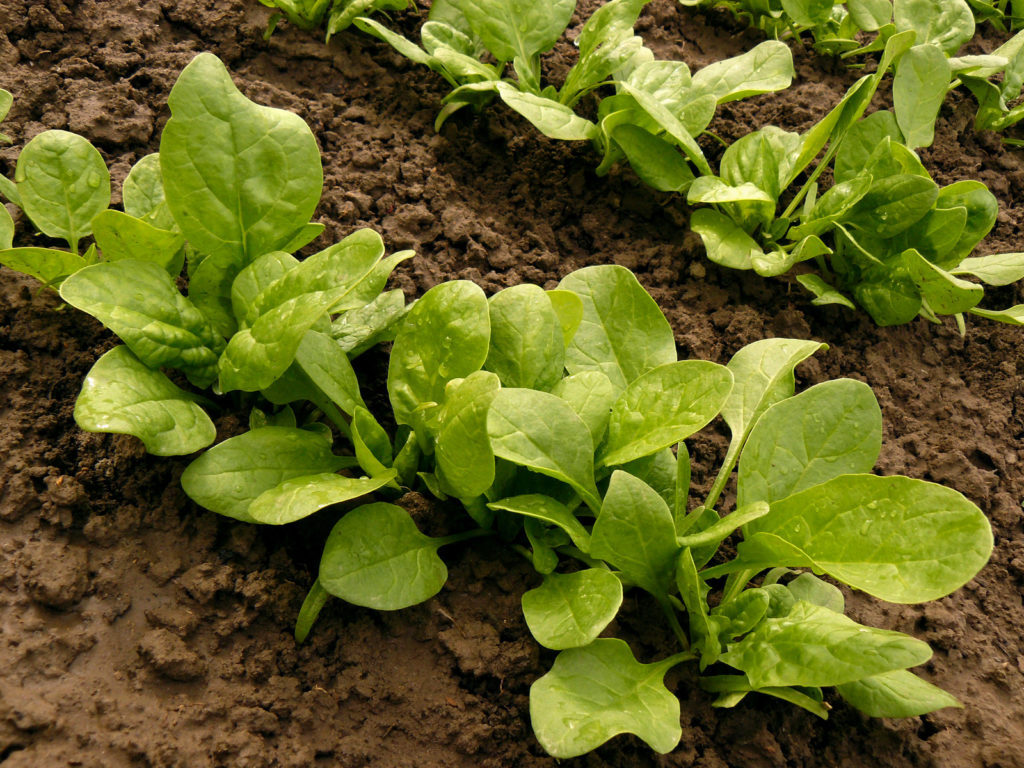Vegetable crop yields and the number of vegetable plants to grow for each person in your household will help you estimate the space needed for a home vegetable garden.
Crop yield estimates and consumption predictions are primarily based on experience. Keeping a food log and garden record can help you hone your vegetable garden needs and make for more thoughtful planning.
Vegetable crop yields will vary according to garden conditions and the variety planted. Weather and growing conditions can change from year to year, and these changes can affect yield.

Estimating vegetable crop yields
Estimating a crop yield before harvest can aid in planning the use of your garden space. Estimating how much each person in your household consumes will also help you determine how much to plant. Knowing how much space each plant requires and when it will reach harvest will help you determine how much space to set aside for each crop and when.
Crop yield estimates and consumption predictions are primarily based on experience. Your vegetable needs may change from year-to-year.
Keeping a food log will help you determine how much to grow for your household. Record how often you eat lettuce, for example, and you will soon determine how much to grow. Do you eat tomatoes fresh or do you process and freeze them for winter use–or both? A food log is a simple way to learn about your eating habits and preferences.
Garden Planning Books at Amazon:
- Vegetable Garden Almanac & Planner
- Kitchen Garden Grower’s Guide Vegetable Encyclopedia
- Tomato Grower’s Answer Book
- Vegetable Garden Grower’s Guide
Estimating yield method
To estimate crop yields in your garden, follow these steps:
- Select a 10-foot section of a row to measure your harvest. If you plant wide rows or intensive beds, measure plantings and harvest by the square foot.
- Note the number of plants growing in the measured section. Be sure to note the cultivar or variety of plants you are growing. Differing cultivars can vary in yield.
- Harvest the crop from the measured section.
- Weigh the sample harvest for total yield; you can also count the yield bean-by-bean or tomato-by-tomato.
- Record the results so that you can plan and compare the results to future harvests.
Yields will vary according to garden conditions and the variety planted. Weather and growing conditions can change from year to year; these changes can affect yield.
Choosing crops to plant
Here are important considerations in choosing crops for planting in the home garden:
- Grow what you will eat or what you can store or give away. Overplanting requires time, energy, and natural resources.
- Grow what you can’t buy. Grow crops that are hard to come by at the farmers’ market or grocery store. Choose varieties recommended by friends and neighbors.
- Grow crops that are expensive to buy at the farmers’ market or grocery store but easily grown at home.
- Grow what tastes best home-grown. Peas and sweet corn taste much better fresh from the garden.
Crop-by-crop yield estimator
Here are crop yield estimates, plants-per-person suggestions, and crop spacing requirements to help you estimate your garden space requirements and growing requirements. A note regarding crop spacing: There are two ways to plant vegetables: (1) traditional rows–single plant rows with space between each row for walking or for moving a tractor through the field; (2) narrow bed, wide rows where plants are space across a narrow bed 24 to 26 inches wide in wide rows where plants are spaced equidistant from one another. The advantage of wide-row planting: you will grow two to three times more than you would grow in a traditional row.
The following illustration shows how plants are set equidistant in wide rows.

Use these estimates with your own experience:
Artichoke. Grow 1 to 2 plants per person. Yield 12 buds per plant after the first year. Space plants 4 to 6 feet apart.
Arugula. Grow 5 plants per person. Space plants 6 inches equidistant apart.
Asparagus. Grow 30 to 50 roots for a household of 2 to 4 people. Yield 3 to 4 pounds of spears per 10-foot row. Space plants 12 inches apart equidistant.
Bean, Dried. Grow 4 to 8 plants per person. Yield in pounds varies per variety—space plants 1 to 3 inches apart equidistant or in rows 2 to 3 feet apart.
Bean, Fava. Grow 4 to 8 plants per person—space plants 4 to 5 inches apart equidistant or in rows 18 to 30 inches apart.
Bean, Garbanzo, Chickpea. Grow 4 to 8 plants per person. Yield 4 to 6 pounds per 10-foot row. Space plants 3 to 6 inches apart equidistant or in rows 24 to 30 inches apart.
Bean, Lima. Grow 4 to 8 per person. Yield 4 to 6 pounds per 10-foot row. Space bush lima beans 3 to 6 inches apart equidistant or in rows 24 to 30 inches apart; increase distance for pole limas.
Beans, Snap. Grow 4 to 8 plants total of each variety or several varieties per person. Yield 3 to 5 pounds per 10-foot row. Space plants 1 to 3 inches apart equidistant or in rows 2 to 3 feet apart.
Beans, Soy. Grow 4 to 8 plants per person. Yield 4 to 6 pounds per 10-foot row. Space plants 2 inches apart equidistant or in rows 2 to 3 feet apart.
Beets. Grow 5 to 10 mature plants per person. Yield 8 to 10 pounds per 10-foot row. Space plants 3 inches apart equidistant for roots–1 inch apart for greens.
Broccoli. Grow 2 to 4 plants per person. Yield 4 to 6 pounds per 10-foot row. Space plants 18 to 24 inches apart equidistant or in rows 3 feet apart.
Brussels sprouts. Grow 1 to 2 plants per person. Yield 3 to 5 pounds per 10-foot row. Space plants 18 to 24 inches apart equidistant or in rows 36 inches apart.
Cabbage. Grow 4 to 8 plants per person. Yield 10 to 25 pounds per 10-foot row. Space plants 24 to 30 inches apart equidistant or in rows 30 to 36 inches apart.
Carrots. Grow 30 plants per person. Yield 7 to 10 pounds per 10-foot row. Thin plants to 1½ to 2 inches apart equidistant or in rows 12 inches apart.
Garden Planning Books at Amazon:
- Vegetable Garden Almanac & Planner
- Kitchen Garden Grower’s Guide Vegetable Encyclopedia
- Tomato Grower’s Answer Book
- Vegetable Garden Grower’s Guide
Cauliflower. Grow 1 to 2 plants per person. Yield 8 to 10 pounds per 10-foot row. Space plants 18 to 24 inches apart equidistant or in rows 3 feet apart.
Celery. Grow 5 plants per person. Yield 6 to 8 stalks per plant. Space plants 6 inches apart equidistant or in rows 2 feet apart.
Chayote. Grow 1 vine for 1 to 4 people. Set vining plants 10 feet apart and train to a sturdy trellis or wire support.
Chicory. Grow 1 to 2 plants per person. Space plants 6 to 12 inches equidistant or apart in rows 2 to 3 feet apart.
Chinese Cabbage. Grow 6 to 8 heads per person. Space plants 4 inches apart equidistant or in rows 24 to 30 inches apart.
Collards. Grow 2 to 3 plants per person. Yield 4 to 8 pounds per 10-foot row. Space plants 15 to 18 inches apart equidistant or in rows 3 feet apart.
Corn. Grow 12 to 20 plants per person. Yield 1 to 2 ears per plant, 10 to 12 ears per 10-foot row. Space plants 8 inches apart in rows 2 to 3 feet apart. Plant corn in blocks of 3 or more rows.
Cucumber. Grow 6 plants per person. Grow 3 to 4 plants per quart for pickling. Yield 8 to 10 pounds per 10-foot row. Space plants 1 to 3 feet apart equidistant or in rows 3 to 6 feet apart.
Eggplant. Grow 1 to 2 plants per person. Yield 8 fruits per Italian oval variety; yield 10 to 15 fruits per Asian variety. Space plants 24 to 30 inches apart equidistant or in rows 3 feet apart.
Endive and Escarole. Grow 2 to 3 plants per person. Yield 3 to 6 pounds per 10-foot row. Space plants 6 to 12 inches apart equidistant or in rows 2 to 3 feet apart.
Garlic. Grow 12 to 16 plants per person. Yield 10 to 30 bulbs per 10-foot row. Space cloves 3 to 6 inches apart equidistant or in rows 15 inches apart.
Horseradish. Grow 1 plant per person. Space plants 30 to 36 inches apart.
Jicama. Grow 1 to 2 plants per person. Yield 1 to 6-pound tuber per plant. Space plants 8 to 12 inches apart equidistant.
Kale. Grow 4 to 5 plants per person. Yield 4 to 8 pounds per 10-foot row. Space plants 12 inches apart equidistant or in rows 12 inches apart.
Kohlrabi. Grow 4 to 5 plants per person. Yield 4 to 8 pounds per 10-foot row. Space plants 4 to 6 inches apart equidistant or in rows 30 inches apart.
Leeks. Grow 12 to 15 plants per person. Yield 4 to 6 pounds per 10-foot row. Space plants 2 to 4 inches apart equidistant or in rows 6 to 10 inches apart.

Lettuce. Grow 6 to 10 plants per person; plant succession crops with each harvest. Yield 4 to 10 pounds per 10-foot row. Space looseleaf lettuce 4 inches apart equidistant and all other types 12 inches apart equidistant or in rows 16 to 24 inches apart.
Melon. Grow 2 to plants per person. Yield 2 to 3 melons per vine. Space plants 3 to 4 feet apart equidistant or in rows 3 feet wide.
Mustard. Grow 6 to 10 plants per person. Yield 3 to 6 pounds per 10-foot row. Space plant 6 to 12 inches apart equidistant or in rows 15 to 30 inches apart.
Okra. Grow 6 plants per person. Yield 5 to 10 pounds per 10-foot row. Space plants 12 to 18 inches apart equidistant or in rows 2½ to 4 feet apart.
Onion, Bulb. Yield 7 to 10 pounds of bulbs per 10-foot row. Space onion sets or transplants 4 to 5 inches apart equidistant or in rows 18 inches apart.
Parsnip. Grow 10 plants per person. Yield 10 pounds per 10-foot row. Space plants 3 to 4 inches apart equidistant or in rows 24 inches apart.
Peas. Grow 30 plants per person. Yield 2 to 6 pounds per 10-foot row. Space plants 2 to 4 inches apart equidistant or in rows 2 feet apart for bush peas, and 4 to 6 inches apart for vining peas.
Pepper. Grow 2 to 3 plants per person. Yield 5 to 18 pounds per 10-foot row. Space plants 18 to 24 inches apart equidistant or in rows 28 to 36 inches apart.
Potato. Grow 1 plant to yield 5 to 10 potatoes. Yield 10 to 20 pounds per 10-foot row. Space seed potatoes 10 to 14 inches apart equidistant or in trenches 24 to 34 inches apart.
Garden Planning Books at Amazon:
- Vegetable Garden Almanac & Planner
- Kitchen Garden Grower’s Guide Vegetable Encyclopedia
- Tomato Grower’s Answer Book
- Vegetable Garden Grower’s Guide
Pumpkin. Grow 1 to 2 plants per person. Yield 10 to 20 pounds per 10-foot row. Space bush pumpkins 24 inches apart in rows 3 feet apart. Set 2 to 3 vining pumpkins on hills spaced 6 to 8 feet apart.
Radicchio. Grow 5 to 6 plants per person. Space plants 6 inches apart equidistant or in rows 18 inches apart.
Radish. Grow 15 plants per person. Yield 2 to 5 pounds per 10-foot row. Space plants 2 to 3 inches apart equidistant or in rows 12 to 18 inches apart.
Rhubarb. Grow 2 to 3 plants per person. Yield 1 to 5 pounds per plant. Set plants 3 to 6 feet apart.
Rutabaga. Grow 5 to 10 plants per person. Yield 8 to 30 pounds per 10-foot row. Space plants 4 to 6 inches apart equidistant or in rows 15 to 36 inches apart.
Salsify. Grow 10 plants per person. Space plants 3 to 4 inches apart equidistant or in rows 20 to 30 inches apart.
Scallions. Yield 1½ pounds per 10-foot row. Spaces onion sets or plants 2 inches apart for scallions or green onions.
Shallot. Yield 2 to 12 cloves per plant. Space plants 5 to 8 inches apart equidistant or in rows 2 to 4 feet apart.
Sorrel. Grow 3 plants per person. Space plants 12 inches apart equidistant or in rows 18 inches apart.

Spinach. Grow 15 plants per person. Yield 4 to 7 pounds per 10-foot row. Space plants 6 inches apart equidistant or in rows 1 to 2 feet apart.
Squash, Summer. Grow 1 to 2 plants per person. Yield 10 to 80 pounds per 10-foot row. Space plants 2 to 4 feet apart equidistant or in rows 5 feet apart.
Squash, Winter. Grow 1 plant per person. Space plants 5 feet apart.
Sunchokes. Grow 5 to 10 plants per person. Space plants 24 inches apart equidistant or in rows 36 to 40 inches apart.
Sunflower. Grow 1 plant per person. Yield 1 to 2½ pounds of seed per flower. Space plants 8 to 12 inches apart equidistant or in rows 30 to 36 inches apart.
Sweet Potato. Grow 5 plants per person. Yield 8 to 12 pounds per 10-foot row. Space plants 12 inches apart equidistant or in rows 3 feet apart.
Swiss Chard. Grow 2 to 3 plants per person. Yield 8 to 12 pounds per 10-foot row. Space plants 12 inches apart equidistant or in rows 18 to 30 inches apart.
Tomatillo. Grow 1 to 2 plants per person. Yield 1 to 2 pounds per plant. Space plants 10 inches apart equidistant or in rows 2 feet apart.
Tomato, Cherry. Grow 1 to 4 plants per person. Space plants 3 feet apart in rows 35 to 45 inches apart.
Tomato, Cooking. Grow 3 to 6 plants of each variety; this will yield 8 to 10 quarts. Space plants 42 inches apart in rows 40 to 50 inches apart.
Tomato, Slicing. Grow 1 to 4 plants per person. Space plants 42 inches apart in rows 40 to 50 inches apart.
Turnip. Grow 5 to 10 plants per person. Yield 8 to 12 pounds per 10-foot row. Space plants 5 to 8 inches apart equidistant or in rows in rows 15 to 24 inches apart.
Watermelon. Grow 2 plants per person. Yield 8 to 40 pounds per 10-foot row. Space plants 4 feet apart in rows 4 feet wide and 8 feet apart.
How to value vegetable crop quality
How do you put a value on your vegetable garden and the crops you grow? It depends upon what you want in return for the time you spend and the space your garden requires.
Fresh vegetables. If you want a steady supply of fresh vegetables for the table, make small successive planting over several weeks or a month or two so that your crops will come to harvest in small quantities and can be taken fresh to the table at harvest.
Here are ways to value your vegetable harvest:
- Flavor. If you are gardening for flavor, grow crops that you can pick at their peak and serve immediately. These are crops that do not store well, and that will lose flavor in even a few days: tomatoes, sweet corn, and peas.
- Storing. If you are growing to keep vegetables on hand over several weeks or months, choose vegetables that will not lose flavor or texture when kept in the refrigerator or pantry: cabbage, potatoes, and dry onions.
- Freezing, canning, or drying. If you plan to preserve your crops for long-term use, you will need larger quantities of a crop and all of the crops should come to harvest at the same time.
High-value home-grown vegetables
Here’s my list of crops that will give you very good value for your time, effort, and space.
- Tomatoes: Grow two plants for each person in the family.
- Bush beans: Grow 5 feet of row for each person.
- Beets: Grow 2 feet of row for each person, but sow several times in succession.
- Carrots: Grow 2 feet of row for each person; make several sowing.
- Lettuce: Grow 3 feet of row for each person; make three sowings.
- New Zealand spinach: Grow 2 feet of row for each person.
- Radishes: Grow 1 foot of row for each person; make 3 or 4 succession sowings.
- Swiss chard: Grow 3 feet of row for each person.
Agronomists at Washington State University Extension compared the relative quality, productivity, and monetary value of commonly homegrown vegetables. They made three comparisons: 1) the quality of garden-grown crops to store-bought crops; 2) the crop yield to the square feet required to grow the crop; 3) the money saved by growing your own compared to the cost at the grocery store. A “High” rating is the best value.
How vegetables compare in quality, production, and monetary value*
| Vegetable | Garden vs. store difference in quality | Yield per square foot | Relative monetary value |
|---|---|---|---|
| Asparagus | high | medium | high |
| Beans, bush | medium | high | medium |
| Beans, pole | medium | high | |
| Beets | low | high | medium |
| Broccoli | medium | high | high |
| Brussels sprouts | high | low | high |
| Cabbage | low | medium | low |
| Carrots | medium | high | medium |
| Cauliflower | low | medium | high |
| Celery | low | medium | medium |
| Chard | high | high | medium |
| Cucumbers | medium | low | high |
| Eggplant | high | low | high |
| Kohlrabi | low | medium | medium |
| Lettuce, leaf | medium | medium | high |
| Lettuce, head | low | low | medium |
| Muskmelon | low | low | medium |
| Onions, green | high | high | high |
| Onions, dry | low | medium | low |
| Parsnips | low | medium | medium |
| Peas | high | medium | medium |
| Peppers | medium | low | high |
| Potatoes | low | medium | low |
| Pumpkin | low | low | low |
| Radish | low | high | medium |
| Rhubarb | medium | high | high |
| Spinach | medium | low | medium |
| Squash, summer | high | high | high |
| Squash, winter | low | medium | low |
| Tomatoes | high | medium | high |
| Turnips | low | high | medium |
| Watermelon | low | low | low |
*Source: Washington State University Extension
Related Articles:
How Big Should Your Vegetable Garden Be
Narrow Beds, Not Rows, For Planting
Wide Row Vegetable Garden Beds
Small Vegetable Garden Space Savers
Garden Planning Books at Amazon:
- Vegetable Garden Almanac & Planner
- Kitchen Garden Grower’s Guide Vegetable Encyclopedia
- Tomato Grower’s Answer Book
- Vegetable Garden Grower’s Guide















